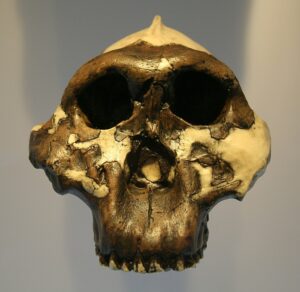What is Lomekwien?
In 2011, the West Turkana Archaeological Project (WTAP) team began archaeological excavations at the Lomekwi site. This site is located in the Nachukui formation, west of Lake Turkana in Kenya (Africa).

During excavations carried out in 2011, the team discovered lithic artifacts in the Lomekwi 3 locality. Continuing their work in 2012, the researchers unearthed a total of 149 lithic pieces. This lithic assemblage is dated at 3.3 million years (later abbreviated to Ma). It comprises 83 shaped tools, 35 flakes, 7 passive elements or potential anvils, 7 strikers, 5 shaped pebbles and 12 undetermined lithic artefacts. This discovery was published in 2015 in the journal Nature.

The lithic pieces found at Lomekwi stand out for their large size and volume. Indeed, the largest tools can weigh up to 15 kg! Most of these tools show traces of percussive shaping on a platform. Following their discovery, an experimental program was set up to determine more precisely how they were manufactured. During the experiments, the researchers used the same raw material as that found at Lomekwi, so as not to skew the results. These experiments showed that the tools were manufactured using passive percussion techniques on anvil and/or bipolar.


All the lithic pieces found at Lomekwi have features indicating deliberate cutting by human hands.
The study carried out by the WTAP team shows that these tools are different from the later cultures already known. Consequently, a new term, “Lomekwien”, is proposed to designate this new lithic industry, in reference to the place where it was discovered. The Lomekwian began at around 3.3 Ma and ended with the onset of the Oldowayen, at around 2.6 Ma. This lithic industry is unique to Africa. If you’d like to find out more about the different chronocultures in Africa, we invite you to read this article.
The new questions raised by this discovery
The Lomekwien discovery pushes back the age of the first carved tools by almost 700,000 years. Indeed, the oldest known artifacts were dated at around 2.6 Ma for the Gona site, 2.36 Ma for the Hadar site and 2.34 Ma for the Omo site in Ethiopia.

These dates coincided with the existence of the Homo genus, which appeared around 2.8 Ma in Africa. However, Lomekwian tools dating from 3.3 Ma completely call into question this link between the Homo genus and toolmaking. Indeed, the first species to be included in the Homo genus, discovered in 1964 by Louis and Mary Leakey, was named Homo habilis, meaning “skilled man”. This name thus underlines the supposed link between the Homo genus and toolmaking, considered at the time to be specific to our genus. However, the discovery of the Lomekwien definitely casts doubt on this hypothesis. We do not know the author of the Lomekwien, but its discovery was made in the same geographical and chronological zone where the Kenyanthropus platyops species was found.
Kenyanthropus platyops, the potential artisan of Lomekwien
The fossil remains of Kenyanthropus platyops were discovered in 1998 and 1999 at the Lomekwi site, west of Lake Turkana in Kenya. They are dated between 3.5 and 3.3 Ma, and the species was officially described in 2001. The holotype of K. platyops is a skull (KNM-WT 40000) that raises many questions. Indeed, it displays a unique combination of archaic characters, bringing it closer to Australopithecines, and derived characters, similar to those observed in later Hominins. The morphology of the face is particularly remarkable, being flat and projecting very little forward, in contrast to what can be observed in the Australopithecus genus, which lived between 4.2 and 1.9 Ma in Africa.
The species name “platyops” comes from the Greek “platus” meaning flat and “opsis” meaning face. So, although Kenyanthropus platyops is currently attached to the Australopithecines, its phylogenetic position remains debated.
We hope you enjoyed this article! Feel free to ask us questions and give us feedback on the blog. You can also contact us by e-mail. You can also follow us on Instagram, Facebook, TikTok, Twitter and YouTube!
See you soon,
The Prehistory Travel team.
Bibliography :
[1] Dominique Grimaud-Hervé et al.History of ancestors. The great adventure of prehistoryErrances,5th edition, 2015.
[2] Sonia Harmand et al, “3.3-million-year-old stone tools from Lomekwi 3, West Turkana, Kenya”, Nature | 310, vol. 521, 2015.
[3] Meave G. Leakey, “New hominin genus from eastern Africa shows diverse middle Pliocene lineages”, Nature, vol. 410, 2001.



